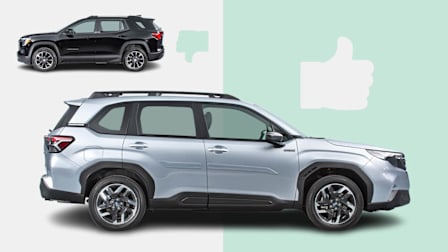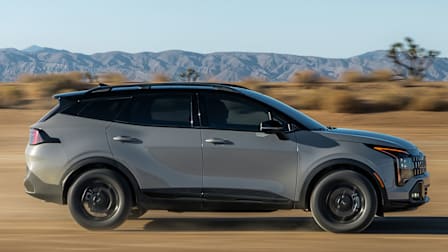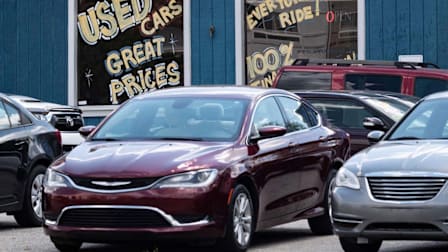Cars Are Expensive. Here’s Why and What You Can Do About It.
Unprecedented market conditions have seen transaction prices rise, but today’s cars remain a strong value

The average cost of new cars is now well over $48,000—up almost $6,000 from two years ago and about $10,000 from September 2020, according to Kelley Blue Book. That figure largely tracks with inflation, but there are many other factors at play.
The car market has become much more complicated because of the enduring disruptions to buying habits, manufacturing, and personal finances caused by the COVID-19 pandemic. In addition to that, buyers have continued to gravitate toward pricey SUVs, and some automakers have discontinued many lower-priced cars in recent years.
In This Article
The Changing Showroom Offerings • The Value Seen in Today’s Cars • New-Car Shopping Today
The Changing Showroom Offerings
The shift in the model mix is profound when you look back just a few years. For example, Ford famously cut cars from its product line this decade to focus on EVs, SUVs, and pickup trucks, which made the average transaction price for Ford soar. To illustrate, below we feature Ford models that were offered in 2019 and since retired, and their prices. By contrast, we list new models currently available and their 2023 prices.
Fords No Longer With Us
EcoSport, $19,995-$27,610
Fiesta, $14,260-$21,340
Flex, $30,575-$43,590
Fusion, $22,840-$40,015
Taurus, $27,800-$42,975
Ford Has Added
Bronco, $32,295-$73,780
Bronco Sport, $29,215-$44,655
F-150 Lightning, $59,974-$98,074
Maverick, $22,195-$30,175
Mach-E, $45,995-$63,995
Another clear example can be found with Chevrolet. Here we look at the cars offered in 2019 that will be retired by 2024, and the new models expected that year.
Chevrolet in 2019 Offered
Bolt, $36,620-$40,905
Camaro, $25,905-$67,500
Cruze, $17,995-$26,120
Impala, $28,020-$36,720
Sonic, $15,420-$21,520
Spark, $13,220-$17,720
Volt, $33,200-$37,570
Chevrolets Coming for 2024
Blazer EV, $47,595-$65,995
Equinox EV, $30,000-$48,000
Silverado EV, $39,900-$105,000
Of course, electric vehicle prices will continue to come down as technology advances, and as new mining operations and factories come online. But for now, EVs do play a role in the shifting automotive landscape.
However, if you look beyond EVs, large SUVs, and pickup trucks, you’ll find that mainstream small and midsized cars and SUVs are still often a good value.
“Sharp shoppers know that if you look beyond the flashiest new models, there is still lots of value in today’s car market. Cars like the Toyota Corolla and Subaru Forester are excellent values and are actually cheaper today than they were 20 years ago when you adjust their prices for inflation,” says Jake Fisher, senior director of Consumer Reports’ auto test program. “Even though the new models are larger, safer, faster, cleaner, more fuel efficient, and packed with features, they are actually more affordable too.”
Over those same two decades, average fuel economy improved 30 percent, resulting in an average of $7,000 in per-vehicle lifetime fuel savings for model year 2021 vehicles compared with model year 2003. Safety also significantly improved as crash-test standards were raised, electronic stability control and backup cameras were mandated on new vehicles, and advanced driver assistance systems became more widely available.
The sticker shock may be real, but the prices are not unreasonable from a historical perspective when comparing similar models. Consumers are getting their money’s worth and then some, as long as they refuse to pay a significant premium over the sticker price.
“Buyers shouldn’t base their spending goals on the market average,” says Gabe Shenhar, Consumer Reports’ associate director who manages CR’s car purchasing and testing. “Instead focus on your own budget and needs. Especially with elevated interest rates on loans, keeping up with the Joneses is an expensive pursuit that can be avoided.”
The Value Seen in Today’s Cars
Look no further than our 2023 10 Top Picks to find good cars available for well under the so-called average new-car price. The Toyota Corolla starts at around $21,500—much less than half the current new-car transaction average. This imminently practical sedan meets our stringent criteria to be a Top Pick: An Overall Score that’s among the highest in its category, factoring road-test performance, predicted reliability, owner satisfaction, and safety, including having standard forward collision warning and automatic emergency braking with pedestrian detection. Further, the base Corolla returned 36 mpg overall in our fuel-economy tests, and it recorded 51 mpg on the highway circuit. With even greater efficiency, the Corolla Hybrid delivered 48 mpg overall in our tests. Buying a Corolla sedan is a smart money move.
New-Car Shopping Today
This continues to be a challenging time for car buyers because of limited inventory and expensive loans. Those seeking a good deal will need to work a little harder than in the past and be more flexible in their choice.
As Consumer Reports studies incentives and transaction data each month, we have seen wild swings in pricing, with some models carrying 5 percent or greater potential discounts. At the same time, other models have been selling for 15 percent above their sticker price. Consequently, even CR testers have found it hard to buy cars at manufacturers’ suggested retail prices for our test program.
We recommend allowing more time to find the right car at an acceptable price and using a car buying service, like CR’s Build & Buy program, to help get a fair deal.
The good news for new car buyers (and our test program!) is that used-car prices continue to be elevated, meaning that you can earn a bit more now on trade-ins now than in years past because of the hunger for lower-priced, pre-owned models. That can dull some of the financial pain.




















